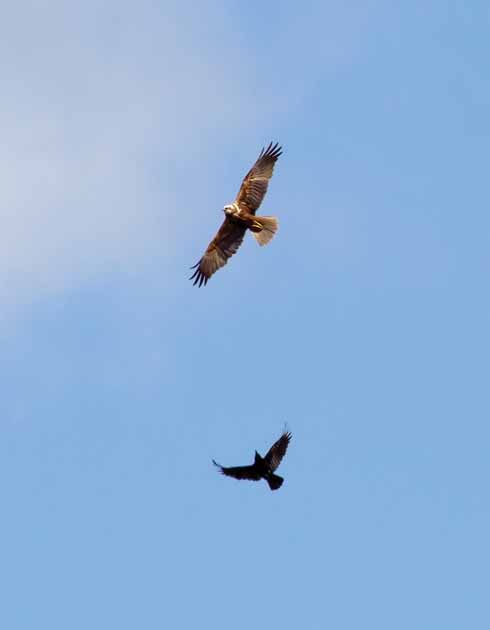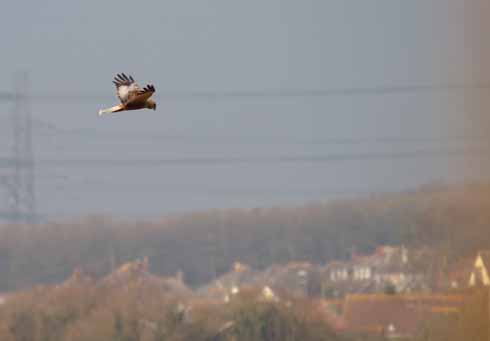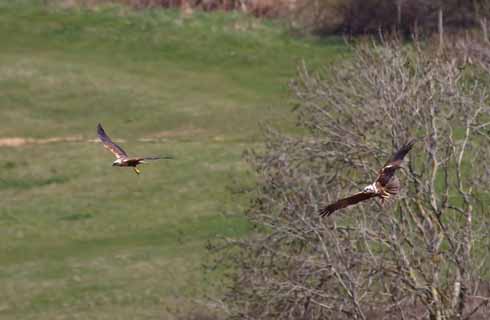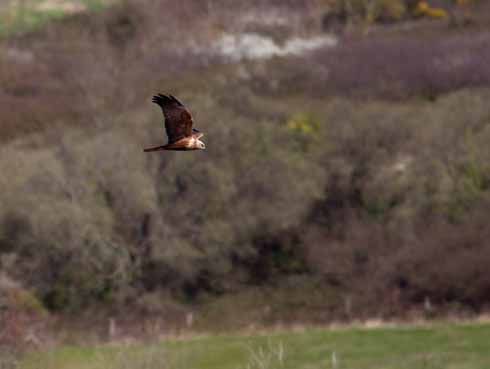Skydancing and sneaking – marsh harriers
Matt Brierley reports on an extraordinary avian love triangle at Radipole Lake
Published in June ’15

The ‘sneak’ male, whose smaller size and dark colouring ensures that he is not perceived as a threat to the other Radipole male marsh harrier
In the sky above Radipole Lake RSPB reserve in Weymouth, a tiny speck hurtles out of the glare of the sun, pirouetting towards the ground. This is a male marsh harrier. In flight his colours are distinct; the head and breast are a pale yellowish white, his back is chestnut, his tail and wings are grey, set-off by striking black tips. His spiralling plummet appears to be cut short as he bounces up again. It looks like he has reached the end of a puppeteer’s invisible string. This is sky-dancing.
His dance is not without an audience. Perched on a thicket in the centre of the wetland’s reed-bed, a female marsh harrier watches; she is one third bigger than her wooer. Her visual acuity enables a detailed appraisal of his skills. In the early morning chill, steam condenses from her nostrils as she calls to him to show her admiration. Her plumage is very different to his – chestnut wings, warm brown underparts and tail, cream collar and head with a distinct brown eye mask.

A rather prescient sign at the Radipole Lake nature reserve; there are indeed some wild discoveries to be made at the reserve
Skydancing is typical marsh harrier behaviour. It is a springtime treat for any nature lover and readily accessible if you want to see it, given that Radipole’s are the UK’s
most urban marsh harriers. Because of this urban proximity, these harriers have been under close scrutiny by the RSPB and staff member Luke Phillips in particular; this has led to an extraordinary discovery.
Three years ago, a third marsh harrier arrived at Radipole. In their first year of life, both male and female marsh harriers look very similar. It is in their second year that a male’s distinct grey and black wings begin to show. Evidently then, this third bird was a young male: it was the same size as a male, but had yet to develop the telltale show-stopping adult plumage.

The much lighter underside plumage of the traditional male (when compared with the female and the sneak marsh harriers) is clearly visible in these two shots
A year later and Luke noticed something unusual: this new bird (which he nick-named Peter Pan) wasn’t sky-dancing. Not only that, but this male harrier wasn’t visibly maturing either. Not only was he behaving as a female would, he was, to all intents and purposes, dressed as one too.
In the sky above Radipole, the showy male continues to dance. He is, as far as he is concerned, courting not one, but two, females. He is, though, sadly deluded. One of his ‘females’ is a sneak: a male marsh harrier in drag who is out to charm the showy male’s intended, while using his feminine cloak to avoid confrontation with the macho skydancing male.

The ‘skydancing’ – ie male in male’s clothing – marsh harrier with Weymouth beyond, overflying his territory without the faintest idea that when he is up and around, there’s an unwanted visitor paying personal calls to Radipole’s female marsh harrier
Skydancing, though, is not the only way a male marsh harrier can woo a girl. Another form of courtship is proffering food during aerial food passes, and under the skydancer’s nose, the sneaky male presents the female with a duck as a gift. Then, they mate. For the female marsh harrier, fertilisation by two males is a smart investment in the future so she can rear a brood with two different fathers.

No soaring skydancing for this underhand male; he simply takes along a quick snack when he visits the female to impress her
It is a little-known, but not unknown, phenomenon for male birds to ‘dress’ as females; some male ruffs – a wading bird that courts females by dancing in leks (groups of male suitors) – also hoodwink other males by sporting drag. Marsh harriers, however, are – as far as we know – the only bird of prey to do it, and the activity had hitherto not been documented in the UK.
The only documented occurrence anywhere in the world had previously been in central western France – where a staggering 40% of the members of the male population adopt this sneaky strategy. Scientists there have observed that a typical male marsh harrier with traditional plumage will violently defend his patch against other traditional males, but treat the sneaks as girls. The sneaky males play their part too, sometimes attacking the females (underlining the optical illusion that they are female), to make it appear that they too are defending territory.
It is probable that Radipole’s ‘Peter Pan’ may only be the tip, as it were, of a cross-dressing iceberg, and that there are male marsh harriers impersonating females across the UK that have gone totally unnoticed until now. Peter Pan may have been the boy who never grew up, but Radipole’s has very much grown up; he simply chooses not to advertise the fact. He is less, perhaps, Peter Pan, more Oskar Matzerath from Günter Grass’s The Tin Drum. ◗
❱ www.rspb.org.uk/community/placestovisit/weymouthwetlands/default.aspx







